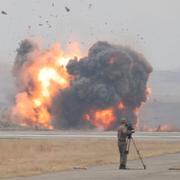bakgrund
Korean Air Lines Flight 007
Wikipedia (en)
Korean Air Lines Flight 007 (also known as KAL007 and KE007) was a scheduled Korean Air Lines flight from New York City to Seoul via Anchorage, Alaska. On September 1, 1983, the South Korean airliner serving the flight was shot down by a Soviet Su-15 interceptor. The Boeing 747 airliner was en route from Anchorage to Seoul, but deviated from its original planned route and flew through Soviet prohibited airspace around the time of a U.S. aerial reconnaissance mission. The Soviet Air Force treated the unidentified aircraft as an intruding U.S. spy plane, and proceeded to destroy it with air-to-air missiles, after firing warning shots which were likely not seen by the KAL pilots. The Korean airliner eventually crashed in the sea near Moneron Island west of Sakhalin in the Sea of Japan. All 269 passengers and crew aboard were killed, including Larry McDonald, a Representative from Georgia in the United States House of Representatives. The Soviets found the wreckage under the sea on September 15, and found the flight recorders in October, but this information was kept secret until 1993.
The Soviet Union initially denied knowledge of the incident, but later admitted shooting down the aircraft, claiming that it was on a MASINT spy mission. The Politburo of the Communist Party of the Soviet Union said it was a deliberate provocation by the United States to probe the Soviet Union's military preparedness, or even to provoke a war. The White House accused the Soviet Union of obstructing search and rescue operations. The Soviet Armed Forces suppressed evidence sought by the International Civil Aviation Organization (ICAO) investigation, such as the flight recorders, which were released eight years later, after the dissolution of the Soviet Union.
The incident was one of the most tense moments of the Cold War and resulted in an escalation of anti-Soviet sentiment, particularly in the United States. The opposing points of view on the incident were never fully resolved; consequently, several groups continue to dispute official reports and offer alternative theories of the event. The subsequent release of Korean Air Lines Flight 007 transcripts and flight recorders by the Russian Federation has clarified some details.
As a result of the incident, the United States altered tracking procedures for aircraft departing from Alaska. The interface of the autopilot used on airliners was redesigned to make it more ergonomic. In addition, the incident was one of the most important events that prompted the Reagan administration to allow worldwide access to the United States Global Positioning System (GPS).




